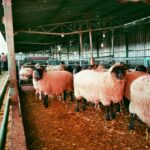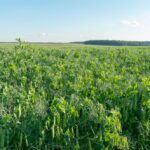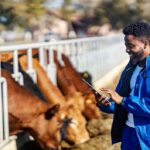India’s agriculture sector has long been vulnerable to the unpredictability of the monsoon season. With over 60% of its agricultural output relying on monsoon rains, accurate forecasting of rainfall patterns is critical for crop planning and resource management. To address this challenge, India has turned to Artificial Intelligence (AI) and machine learning (ML) to predict monsoons with greater accuracy, helping farmers make data-driven decisions. South Africa, with its own agricultural challenges related to rainfall and water scarcity, could potentially benefit from adopting similar AI-driven approaches to improve its agricultural resilience.
The Role of AI in Predicting Monsoons in India
India’s monsoon season is often marked by erratic rainfall patterns, with large regions experiencing either too little or too much rain, which can drastically affect agricultural production. To manage this unpredictability, AI has emerged as a crucial tool for improving monsoon forecasts.
AI and machine learning algorithms are being used to analyze large datasets, including historical weather patterns, satellite imagery, ocean temperature data, and atmospheric conditions. These tools help meteorologists make more precise predictions about the timing, intensity, and duration of monsoon rains. Several key AI initiatives in India are already making significant strides:
- Improved Rainfall Prediction Models: By processing vast amounts of weather data, AI models can predict when and where the monsoon will hit, how intense it will be, and which areas will experience heavy rainfall. This allows farmers to prepare in advance, making decisions on crop planting, irrigation, and fertilization.
- Satellite Data and Remote Sensing: AI systems integrate satellite imagery and remote sensing data to provide real-time monitoring of weather patterns. This technology tracks changes in sea surface temperatures, cloud formation, and wind patterns, which are all indicators of upcoming monsoon conditions.
- Climate Modeling and Forecasting: AI enhances traditional climate modeling, enabling meteorologists to account for more variables and create highly accurate predictions. By simulating various climate scenarios, AI helps forecast how shifting weather patterns, such as the El Niño and La Niña phenomena, might impact the monsoon season.
- AI-Powered Apps for Farmers: In India, AI-powered applications like Digital India and Pradhan Mantri Fasal Bima Yojana (PMFBY) help farmers access personalized monsoon forecasts. These apps provide localized, real-time updates about rainfall predictions, helping farmers decide when to plant, irrigate, and protect their crops from potential damage.
Challenges in Using AI for Monsoon Predictions in India
While AI-driven predictions have improved the accuracy of monsoon forecasts, there are still challenges in fully harnessing this technology. Some of these include:
- Data Quality and Availability: AI systems require large, high-quality datasets to make accurate predictions. In some areas, limited access to reliable weather data or outdated systems can hinder the effectiveness of AI models.
- Complexity of Weather Systems: Monsoons are influenced by a wide range of dynamic and interconnected atmospheric factors. AI models must account for various variables, including sea surface temperatures, wind patterns, and atmospheric pressure systems, making accurate predictions difficult.
- Regional Variability: India’s vast and diverse geography means that rainfall patterns vary significantly across the country. AI models must be able to predict these regional differences accurately, which can be a complex task.
Can South Africa Adopt AI for Monsoon Prediction?
While India’s AI-driven monsoon forecasting systems are tailored to its specific weather patterns, South Africa, with its distinct climate and agricultural challenges, could also benefit from adopting similar technologies. South Africa’s agricultural sector, especially in regions like the Eastern Cape and Western Cape, faces significant water scarcity, erratic rainfall, and unpredictable weather conditions that can have serious consequences for crop yields.
Here are some ways South Africa can leverage AI for better weather predictions:
- Localized Climate Forecasting: South Africa could develop AI systems that focus on localized weather conditions, as rainfall patterns vary widely across the country. With AI models analyzing satellite data, historical rainfall, and atmospheric factors, farmers in different regions could receive highly specific forecasts, enabling them to make more informed decisions about irrigation, planting schedules, and crop selection.
- Water Management: AI models that predict rainfall accurately can help South African farmers optimize water usage. In a country where droughts are frequent, precise predictions of rainfall can help farmers plan their irrigation schedules, preventing overuse or wastage of water.
- Climate Resilience: As climate change continues to affect global weather patterns, AI could play a key role in helping South African farmers adapt. AI models can simulate the impacts of extreme weather events, such as prolonged droughts or floods, helping farmers identify resilient crop varieties and adjust farming practices to cope with changing climate conditions.
- Collaborative Initiatives: South Africa could collaborate with international organizations and research institutions to develop AI-powered weather forecasting systems tailored to its needs. By pooling data and resources, South Africa could improve the quality of weather predictions and make AI more accessible to farmers, particularly those in rural or remote areas.
Challenges for South Africa in Implementing AI for Monsoon Prediction
- Data Infrastructure: Like India, South Africa would need to ensure that sufficient and reliable weather data is available for AI models to work effectively. In some regions, the lack of accurate weather stations and satellite data could pose a challenge.
- Technological Adoption: South African farmers, particularly smallholders, may face challenges in adopting AI technologies due to cost, lack of technical expertise, or limited access to digital tools. Training programs and government support could help mitigate these challenges.
- Infrastructure and Connectivity: AI systems rely on cloud computing and high-speed internet connections. In rural areas, where connectivity may be limited, South Africa will need to invest in digital infrastructure to enable effective use of AI technologies.
India’s success in using AI to predict monsoons offers valuable lessons for South Africa. By leveraging AI and machine learning, South African farmers can improve their ability to predict rainfall, optimize water use, and increase agricultural resilience in the face of unpredictable weather. While challenges remain, the potential benefits of AI in agriculture are significant. By investing in data infrastructure, training programs, and localized forecasting models, South Africa can harness the power of AI to strengthen its agricultural sector and ensure food security in an increasingly volatile climate.
Join 'Farmers Mag' WhatsApp Channel
Get the latest Farming news and tips delivered straight to your WhatsApp
CLICK HERE TO JOIN






